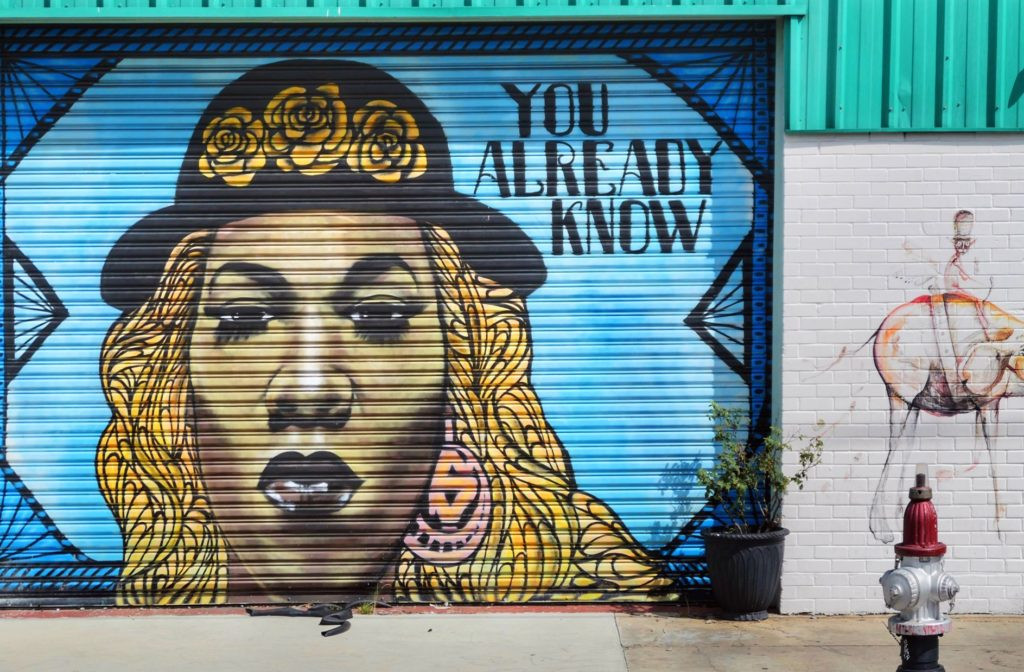Big Freedia, the undisputed queen of Bounce music, is an icon whose influence stretches far beyond the vibrant music scene of New Orleans. Known for high-energy performances and a powerful message of self-acceptance, Freedia’s journey is deeply rooted in the streets of her childhood neighborhood. While she navigates the music industry as “Freddie” by day, handling business with sharp focus, it’s “Freedia” by night, the persona celebrated on stages worldwide. This duality reflects a life shaped by the rich, and sometimes harsh, realities of New Orleans, particularly her upbringing in the Third Ward near Josephine Street.
 Big Freedia mural in New Orleans, celebrating the bounce music icon's connection to her childhood neighborhood near Josephine Street
Big Freedia mural in New Orleans, celebrating the bounce music icon's connection to her childhood neighborhood near Josephine Street
For Big Freedia, identity is a fluid concept, comfortable embracing both masculine and feminine expressions. Growing up in New Orleans, she witnessed firsthand the struggles of her community. Her childhood, spent in the Third Ward, was a formative experience that shaped her resilience and artistic vision. Despite the presence of “drugs and violence and poverty,” Freedia’s family, with a mother who was a hairdresser and a father and stepfather who were truck drivers, strived to shield their children and instill optimism. This environment, both challenging and nurturing, became the backdrop for her formative years, deeply connected to Josephine Street.
Josephine Street, in the Third Ward near the Melpomene housing project, was more than just an address; it was the center of her childhood world. Describing it as lined with “all different types of little houses,” Freedia recalls her family home, a “two-bedroom shotgun right on the corner.” This imagery evokes a sense of close-knit community and the typical New Orleans architecture that defines neighborhoods like the Third Ward. Josephine Street was where life unfolded, friendships were forged, and the seeds of her musical journey were sown.
Childhood on Josephine Street was characterized by a freedom and simplicity that contrasts sharply with today’s digital age. After school, Freedia and her friend Adolphe, who lived nearby, would often head to the Melpomene project to meet up with Katey Red, another influential figure in the Bounce scene. Their days were filled with outdoor activities: “skates,” “bikes,” “jacks,” and “cards”—simple games that fostered social interaction and creativity. This was a time before the pervasive influence of “social media” and “video games,” when children created their own entertainment and found joy in communal play. These experiences on Josephine Street were crucial in developing Freedia’s social skills and community bonds, essential elements in Bounce music’s call-and-response dynamic.
Freedia describes herself as a “happy, fat kid” who “loved to eat” and embraced her size. This self-acceptance, even in childhood, is a recurring theme in her life and music. While comfortable in her own skin, she also recounts being “picked on for being chubby” and “for being gay.” These experiences, although painful, contributed to her strength and resilience. One particular incident with her stepfather, who challenged her strength, became a turning point. Her physical response, flipping him “upside down,” earned her respect and demonstrated a hidden strength, both literally and metaphorically. This anecdote highlights the challenges and triumphs of growing up while navigating identity and societal expectations in her Josephine Street neighborhood.
Sunday mornings held a special significance, centered around church and music. Freedia’s eagerness for church was driven by a love for “the music,” “the preacher preaching,” and “the Sunday school lesson.” Her involvement deepened when she became her godmother’s assistant in the choir. However, this spiritual space was not without its complexities. As a “young, Black, gay kid,” Freedia encountered sermons that were “very offended by…being a homosexual.” These moments of rejection led her and the gay organist to retreat, finding solace in shared understanding and the reassuring words of supportive church mothers and her godmother, who emphasized God’s universal love and acceptance. This early experience with both acceptance and rejection within the church community reflects the broader societal challenges faced by LGBTQ+ individuals, even within supportive communities like those found near Josephine Street.
Music was the ever-present soundtrack to life on Josephine Street and beyond. Freedia’s upbringing was immersed in the sounds of the era, listing iconic artists like “Jodeci and Levert,” “Michael Jackson,” “Prince,” and “Patti Labelle.” Her mother’s favorite, “Happy Feelin’s” by Frankie Beverly and Maze, with its message of joy and emotional expression through music, resonated deeply. This diverse musical landscape laid the foundation for Freedia’s own groundbreaking contribution: Bounce music.
Bounce music, with its “up-tempo, heavy bass, call-and-response type of music,” is distinctly New Orleans. Freedia credits the “DJs who created the sound of Bounce here in New Orleans” as pioneers. Her entry into music was organic and playful, starting as “kids” “beating on the electric machines in the project hallway” and “on the staircase rail.” From these humble beginnings on the streets of her neighborhood, including Josephine Street, Freedia’s journey has been extraordinary. Becoming “an icon in the Bounce game and for New Orleans” is a testament to her talent, resilience, and deep connection to her roots.
Big Freedia’s vision for Bounce music extends far beyond New Orleans. She sees it as a unique genre deserving of global recognition, envisioning “categories on music charts” and awards. Just as New Orleans is celebrated for its diverse musical heritage, Freedia champions Bounce as a vital part of this cultural tapestry. Her story, deeply intertwined with Josephine Street and the Third Ward, is a powerful narrative of personal and artistic growth, rooted in community, resilience, and the transformative power of music.
